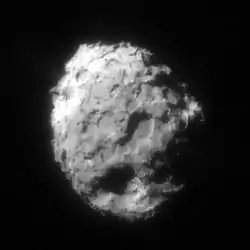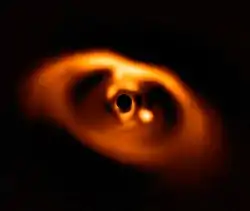Interstellar object
An interstellar object is an astronomical object (such as an asteroid, a comet, or a rogue planet, but not a star) in interstellar space that is not gravitationally bound to a star. This term can also be applied to an object that is on an interstellar trajectory but is temporarily passing close to a star, such as certain asteroids and comets (including exocomets[1][2]). In the latter case, the object may be called an interstellar interloper.[3]
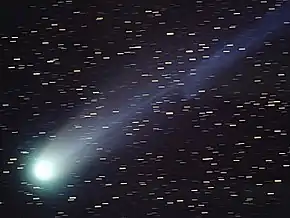
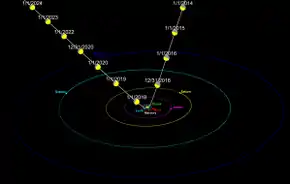
The first interstellar object to be discovered in the Solar System was 1I/ʻOumuamua in 2017. The second was 2I/Borisov in 2019. They both possess significant hyperbolic excess velocity, indicating they did not originate in the Solar System.
Nomenclature
With the first discovery of an interstellar object, the IAU has proposed a new series of small-body designations for interstellar objects, the I numbers, similar to the comet numbering system. The Minor Planet Center will assign the numbers. Provisional designations for interstellar objects will be handled using the C/ or A/ prefix (comet or asteroid), as appropriate.[4]
Overview
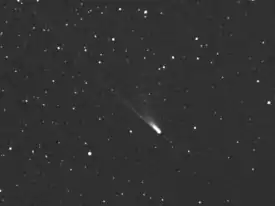

Astronomers estimate that several interstellar objects of extrasolar origin (like ʻOumuamua) pass inside the orbit of Earth each year,[5] and that 10,000 are passing inside the orbit of Neptune on any given day.[6]
If interstellar comets exist, they must occasionally pass through the inner Solar System.[1] They would approach the Solar System with random velocities, mostly from the direction of the constellation Hercules because the Solar System is moving in that direction, called the solar apex.[7] Until the discovery of 'Oumuamua, the fact that no comet with a speed greater than the Sun's escape velocity[8] had been observed was used to place upper limits to their density in interstellar space. A paper by Torbett indicated that the density was no more than 1013 (10 trillion) comets per cubic parsec.[9] Other analyses, of data from LINEAR, set the upper limit at 4.5×10−4/AU3, or 1012 (1 trillion) comets per cubic parsec.[2] A more recent estimate by David C. Jewitt and colleagues, following the detection of 'Oumuamua, predicts that "The steady-state population of similar, ~100 m scale interstellar objects inside the orbit of Neptune is ~1×104, each with a residence time of ~10 years."[10]
Current models of Oort cloud formation predict that more comets are ejected into interstellar space than are retained in the Oort cloud, with estimates varying from 3 to 100 times as many.[2] Other simulations suggest that 90–99% of comets are ejected.[11] There is no reason to believe comets formed in other star systems would not be similarly scattered.[1] Amir Siraj and Avi Loeb demonstrated that the Oort Cloud could have been formed from ejected planetesimals from other stars in the Sun's birth cluster. [12][13][14]
It is possible for objects orbiting a star to be ejected due to interaction with a third massive body, thereby becoming interstellar objects. Such a process was initiated in the early 1980s when C/1980 E1, initially gravitationally bound to the Sun, passed near Jupiter and was accelerated sufficiently to reach escape velocity from the Solar System. This changed its orbit from elliptical to hyperbolic and made it the most eccentric known object at the time, with an eccentricity of 1.057.[15] It is heading for interstellar space.
Due to present observational difficulties, an interstellar object can usually only be detected if it passes through the Solar System, where it can be distinguished by its strongly hyperbolic trajectory and hyperbolic excess velocity of more than a few km/s, proving that it is not gravitationally bound to the Sun.[2][16] In contrast, gravitationally bound objects follow elliptic orbits around the Sun. (There are a few objects whose orbits are so close to parabolic that their gravitationally bound status is unclear.)
An interstellar comet can probably, on rare occasions, be captured into a heliocentric orbit while passing through the Solar System. Computer simulations show that Jupiter is the only planet massive enough to capture one, and that this can be expected to occur once every sixty million years.[9] Comets Machholz 1 and Hyakutake C/1996 B2 are possible examples of such comets. They have atypical chemical makeups for comets in the Solar System.[8][17]
Amir Siraj and Avi Loeb proposed a search for ʻOumuamua-like objects which are trapped in the Solar System as a result of losing orbital energy through a close encounter with Jupiter.[18][19] They identified centaur candidates, such as 2017 SV13 and 2018 TL6, as captured interstellar objects that could be visited by dedicated missions.[20] The authors pointed out that future sky surveys, such as with LSST, should find many candidates.
Recent research suggests that asteroid 514107 Kaʻepaokaʻawela may be a former interstellar object, captured some 4.5 billion years ago, as evidenced by its co-orbital motion with Jupiter and its retrograde orbit around the Sun.[21] In addition, comet C/2018 V1 (Machholz-Fujikawa-Iwamoto) has a significant probability (72.6%) of having an extrasolar provenance although an origin in the Oort cloud cannot be excluded.[22] Harvard astronomers suggest that matter—and potentially dormant spores—can be exchanged across vast distances.[23] The detection of ʻOumuamua crossing the inner Solar System confirms the possibility of a material link with exoplanetary systems.
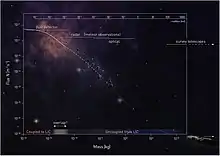
Interstellar visitors in the Solar System cover the whole range of sizes - from kilometer large objects down to submicron particles. Also, interstellar dust and meteoroids carry with them valuable information from their parent systems. Detection of these objects along the continuum of sizes is, however, not evident (see Figure).[25] The smallest interstellar dust particles are filtered out of the solar system by electromagnetic forces, while the largest ones are too sparse to obtain good statistics from in situ spacecraft detectors. Discrimination between interstellar and interplanetary populations can be a challenge for intermediate (0.1-1 micrometer) sizes. These can vary widely in velocity and directionality.[26] The identification of interstellar meteoroids, observed in the Earth’s atmosphere as meteors, is highly challenging and requires high accuracy measurements and appropriate error examinations.[27] Otherwise, measurement errors can transfer near-parabolic orbits over the parabolic limit and create an artificial population of hyperbolic particles, often interpreted as of interstellar origin.[28] Large interstellar visitors like asteroids and comets were detected the first time in the solar system in 2017 (1I/'Oumuamua) and 2019 (2I/Borisov) and are expected to be detected more frequently with new telescopes, e.g. the Vera Rubin Observatory. Amir Siraj and Avi Loeb have predicted that the Vera C. Rubin Observatory will be capable of detecting an anisotropy in the distribution of interstellar objects due to the Sun's motion relative to the Local Standard of Rest and identify the characteristic ejection speed of interstellar objects from their parent stars.[29][30]
Confirmed objects
1I/2017 U1 (ʻOumuamua)
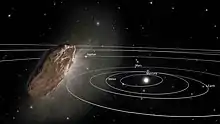
A dim object was discovered on October 19, 2017 by the Pan-STARRS telescope, at an apparent magnitude of 20. The observations showed that it follows a strongly hyperbolic trajectory around the Sun at a speed greater than the solar escape velocity, in turn meaning that it is not gravitationally bound to the Solar System and likely to be an interstellar object.[32] It was initially named C/2017 U1 because it was assumed to be a comet, and was renamed to A/2017 U1 after no cometary activity was found on October 25.[33][34] After its interstellar nature was confirmed, it was renamed to 1I/ʻOumuamua – "1" because it is the first such object to be discovered, "I" for interstellar, and "‘Oumuamua" is a Hawaiian word meaning "a messenger from afar arriving first".[35]
The lack of cometary activity from ʻOumuamua suggests an origin from the inner regions of whatever stellar system it came from, losing all surface volatiles within the frost line, much like the rocky asteroids, extinct comets and damocloids we know from the Solar System. This is only a suggestion, as ʻOumuamua might very well have lost all surface volatiles to eons of cosmic radiation exposure in interstellar space, developing a thick crust layer after it was expelled from its parent system.
| Object | Velocity |
|---|---|
| C/2012 S1 (ISON) (weakly hyperbolic Oort Cloud comet) | 0.2 km/s 0.04 au/yr[36] |
| Voyager 1 (For comparison) | 16.9 km/s 3.57 au/yr[37] |
| 1I/2017 U1 (ʻOumuamua) | 26.33 km/s 5.55 au/yr[38] |
| 2I/Borisov | 32.1 km/s 6.77 au/yr[39] |
| 2014Jan08 bolide (in peer review) | 43.8 km/s 9.24 au/yr[40] |
ʻOumuamua has an eccentricity of 1.199, which was the highest eccentricity ever observed for any object in the Solar System by a wide margin prior to the discovery of comet 2I/Borisov in August 2019.
In September 2018, astronomers described several possible home star systems from which ʻOumuamua may have begun its interstellar journey.[41][42]
2I/Borisov

The object was discovered on 30 August 2019 at MARGO, Nauchnyy, Crimea by Gennadiy Borisov using his custom-built 0.65-meter telescope.[43] On 13 September 2019, the Gran Telescopio Canarias obtained a low-resolution visible spectrum of 2I/Borisov that revealed that this object has a surface composition not too different from that found in typical Oort Cloud comets.[44][45][46] The IAU Working Group for Small Body Nomenclature kept the name Borisov, giving the comet the interstellar designation of 2I/Borisov.[47] On 12 March 2020, astronomers reported observational evidence of "ongoing nucleus fragmentation" from the comet 2I/Borisov.[48]
Candidates
In November 2018, Harvard astronomers Amir Siraj and Avi Loeb reported that there should be hundreds of 'Oumuamua-size interstellar objects in the Solar System, based on calculated orbital characteristics, and presented several centaur candidates such as 2017 SV13 and 2018 TL6.[49] These are all orbiting the Sun, but may have been captured in the distant past.
On 8 January 2014, a bolide which has been identified by Loeb and Siraj as a potentially interstellar object originating from an unbound hyperbolic orbit exploded in the atmosphere over northern Papua New Guinea.[40] It had an eccentricity of 2.4, an inclination of 10°, and a speed of 43.8 km/s when outside of the Solar System. This would make it notably faster than ʻOumuamua which was 26.3 km/s when outside the Solar System. The meteor is estimated to have been 0.9 meters in diameter. Other astronomers doubt the interstellar origin because the meteor catalog used does not report uncertainties on the incoming velocity.[50] The validity of any single data point (especially for smaller meteors) remains questionable.
Amir Siraj and Avi Loeb have proposed methods for increasing the discovery rate of interstellar objects that include stellar occultations, optical signatures from impacts with the moon or the Earth's atmosphere, and radio flares from collisions with neutron stars.[51][52][53][54]
Hypothetical missions
With current space technology, close visits and orbital missions are challenging due to their high speeds, though not impossible.[55]
The Initiative for Interstellar Studies (i4is) launched Project Lyra to assess the feasibility of a mission to ʻOumuamua.[56] Several options for sending a spacecraft to ʻOumuamua within a time-frame of 5 to 25 years were suggested.[57][58] One option is using first a Jupiter flyby followed by a close solar flyby at 3 solar radii (2.1×106 km; 1.3×106 mi) in order to take advantage of the Oberth effect.[59] Different mission durations and their velocity requirements were explored with respect to the launch date, assuming direct impulsive transfer to the intercept trajectory.
The Comet Interceptor spacecraft by ESA and JAXA, planned to launch in 2029, will be positioned at the Sun-Earth L2 point to wait for a suitable long-period comet to intercept and flyby for study.[60] In case that no suitable comet is identified during its 3-year wait, the spacecraft could be tasked to intercept an interstellar object in short notice, if reachable.[61]
See also
- Hyperbolic asteroid
- List of Solar System objects by greatest aphelion – Wikipedia list article
References
- Valtonen, Mauri J.; Zheng, Jia-Qing; Mikkola, Seppo (March 1992). "Origin of oort cloud comets in the interstellar space". Celestial Mechanics and Dynamical Astronomy. 54 (1–3): 37–48. Bibcode:1992CeMDA..54...37V. doi:10.1007/BF00049542. S2CID 189826529.
- Francis, Paul J. (2005-12-20). "The Demographics of Long-Period Comets". The Astrophysical Journal. 635 (2): 1348–1361. arXiv:astro-ph/0509074. Bibcode:2005ApJ...635.1348F. doi:10.1086/497684. S2CID 12767774.
- Veras, Dimitri (13 April 2020). "Creating the first interstellar interloper". Nature Astronomy. 4 (9): 835–836. Bibcode:2020NatAs...4..835V. doi:10.1038/s41550-020-1064-9. ISSN 2397-3366.
- "MPEC 2017-V17 : NEW DESIGNATION SCHEME FOR INTERSTELLAR OBJECTS". Minor Planet Center. 6 November 2017.
- "Interstellar Asteroid FAQs". NASA. 20 November 2017. Retrieved 21 November 2017.
- Fraser, Wesley (11 February 2018). "The Sky at Night: The Mystery of ʻOumuamua" (Interview). Interviewed by Chris Lintott. BBC.
- Struve, Otto; Lynds, Beverly; Pillans, Helen (1959). Elementary Astronomy. New York: Oxford University Press. p. 150.
- MacRobert, Alan (2008-12-02). "A Very Oddball Comet". Sky & Telescope. Retrieved 2010-03-26.
- Torbett, M. V. (July 1986). "Capture of 20 km/s approach velocity interstellar comets by three-body interactions in the planetary system". Astronomical Journal. 92: 171–175. Bibcode:1986AJ.....92..171T. doi:10.1086/114148.
- Jewitt, David; Luu, Jane; Rajagopal, Jayadev; Kotulla, Ralf; Ridgway, Susan; Liu, Wilson; Augusteijn, Thomas (2017). "Interstellar Interloper 1I/2017 U1: Observations from the NOT and WIYN Telescopes". The Astrophysical Journal. 850 (2): L36. arXiv:1711.05687. Bibcode:2017ApJ...850L..36J. doi:10.3847/2041-8213/aa9b2f. S2CID 32684355.
- Choi, Charles Q. (2007-12-24). "The Enduring Mysteries of Comets". Space.com. Retrieved 2008-12-30.
- Siraj, Amir; Loeb, Abraham (2020-08-18). "The Case for an Early Solar Binary Companion". The Astrophysical Journal. 899 (2): L24. arXiv:2007.10339. Bibcode:2020ApJ...899L..24S. doi:10.3847/2041-8213/abac66. ISSN 2041-8213. S2CID 220665422.
- Carter, Jamie. "Was Our Sun A Twin? If So Then 'Planet 9' Could Be One Of Many Hidden Planets In Our Solar System". Forbes. Retrieved 2020-11-14.
- "Did the Sun have an early binary companion?". Cosmos Magazine. 2020-08-20. Retrieved 2020-11-14.
- "JPL Small-Body Database Browser: C/1980 E1 (Bowell)" (1986-12-02 last obs). Retrieved 2010-01-08.
- de la Fuente Marcos, Carlos; de la Fuente Marcos, Raúl; Aarseth, Sverre J. (6 February 2018). "Where the Solar system meets the solar neighbourhood: patterns in the distribution of radiants of observed hyperbolic minor bodies". Monthly Notices of the Royal Astronomical Society Letters. 476 (1): L1–L5. arXiv:1802.00778. Bibcode:2018MNRAS.476L...1D. doi:10.1093/mnrasl/sly019. S2CID 119405023.
- Mumma, M. J.; Disanti, M. A.; Russo, N. D.; Fomenkova, M.; Magee-Sauer, K.; Kaminski, C. D.; Xie, D. X. (1996). "Detection of Abundant Ethane and Methane, Along with Carbon Monoxide and Water, in Comet C/1996 B2 Hyakutake: Evidence for Interstellar Origin". Science. 272 (5266): 1310–1314. Bibcode:1996Sci...272.1310M. doi:10.1126/science.272.5266.1310. PMID 8650540. S2CID 27362518.
- Siraj, Amir; Loeb, Abraham (2019). "Identifying Interstellar Objects Trapped in the Solar System through Their Orbital Paramteters". The Astrophysical Journal. 872 (1): L10. arXiv:1811.09632. Bibcode:2019ApJ...872L..10S. doi:10.3847/2041-8213/ab042a. S2CID 119198820.
- Koren, Marina (23 January 2019). "When a Harvard Professor Talks About Aliens - News about extraterrestrial life sounds better coming from an expert at a high-prestige institution". The Atlantic. Retrieved 23 January 2019.
- Siraj, Amir; Loeb, Abraham (February 2019). "Identifying Interstellar Objects Trapped in the Solar System through Their Orbital Parameters". The Astrophysical Journal. 872 (1): L10. arXiv:1811.09632. Bibcode:2019ApJ...872L..10S. doi:10.3847/2041-8213/ab042a. S2CID 119198820.
- Clery, Daniel (2018). "This asteroid came from another solar system—and it's here to stay". Science. doi:10.1126/science.aau2420.
- de la Fuente Marcos, Carlos; de la Fuente Marcos, Raúl (11 October 2019). "Comet C/2018 V1 (Machholz-Fujikawa-Iwamoto): dislodged from the Oort Cloud or coming from interstellar space?". Monthly Notices of the Royal Astronomical Society. 489 (1): 951–961. arXiv:1908.02666. Bibcode:2019MNRAS.489..951D. doi:10.1093/mnras/stz2229. S2CID 199472877.
- Reuell, Peter (8 July 2019). "Harvard study suggests asteroids might play key role in spreading life". Harvard Gazette. Retrieved 29 September 2019.
- Hajdukova, Maria; Sterken, Veerle; Wiegert, Paul; Kornoš, Leonard (2020-11-01). "The challenge of identifying interstellar meteors". Planetary and Space Science. 192: 105060. Bibcode:2020P&SS..19205060H. doi:10.1016/j.pss.2020.105060. ISSN 0032-0633.
- Hajdukova, M.; Sterken, V.; Wiegert, P.; Kornoš, L. (2020-11-01). "The challenge of identifying interstellar meteors". Planetary and Space Science. 192: 105060. Bibcode:2020P&SS..19205060H. doi:10.1016/j.pss.2020.105060. ISSN 0032-0633.
- Sterken, V. J.; Altobelli, N.; Kempf, S.; Schwehm, G.; Srama, R.; Grün, E. (2012-02-01). "The flow of interstellar dust into the solar system". Astronomy & Astrophysics. 538: A102. Bibcode:2012A&A...538A.102S. doi:10.1051/0004-6361/201117119. ISSN 0004-6361.
- Hajduková, Mária; Kornoš, Leonard (2020-10-01). "The influence of meteor measurement errors on the heliocentric orbits of meteoroids". Planetary and Space Science. 190: 104965. Bibcode:2020P&SS..19004965H. doi:10.1016/j.pss.2020.104965. ISSN 0032-0633.
- Hajdukova, M.; Sterken, V.; Wiegert, P.; Kornoš, L. (2020-11-01). "The challenge of identifying interstellar meteors". Planetary and Space Science. 192: 105060. Bibcode:2020P&SS..19205060H. doi:10.1016/j.pss.2020.105060. ISSN 0032-0633.
- Siraj, Amir; Loeb, Abraham (2020-10-29). "Observable Signatures of the Ejection Speed of Interstellar Objects from Their Birth Systems". The Astrophysical Journal. 903 (1): L20. arXiv:2010.02214. Bibcode:2020ApJ...903L..20S. doi:10.3847/2041-8213/abc170. ISSN 2041-8213. S2CID 222141714.
- Williams, Matt (2020-11-07). "Vera Rubin Should be Able to Detect a Couple of Interstellar Objects a Month". Universe Today. Retrieved 2020-11-14.
- "Solar System's First Interstellar Visitor Dazzles Scientists". NASA/JPL. Retrieved 2017-11-25.
- "MPEC 2017-U181: COMET C/2017 U1 (PANSTARRS)". Minor Planet Center. Retrieved 25 October 2017.
- Meech, K. (25 October 2017). "Minor Planet Electronic Circular MPEC 2017-U183: A/2017 U1". Minor Planet Center.
- "We May Just Have Found An Object That Originated From Outside Our Solar System". IFLScience. October 26, 2017.
- "Aloha, 'Oumuamua! Scientists confirm that interstellar asteroid is a cosmic oddball". GeekWire. 20 November 2017.
- C/2012 S1 (ISON) had an epoch 1600 barycentric semi-major axis of −144956 and would have an inbound v_infinite of 0.2 km/s at 50000 au:
v=42.1219 √1/50000 − 0.5/−144956 - Voyager Fast Facts
- Gray, Bill (26 October 2017). "Pseudo-MPEC for A/2017 U1 (FAQ File)". Project Pluto. Retrieved 26 October 2017.
- Gray, Bill. "FAQ for C/2019 Q4 (Borisov)". Project Pluto. Retrieved 2019-09-24.
- Siraj, Amir; Loeb, Abraham (2019). "Discovery of a Meteor of Interstellar Origin". arXiv:1904.07224 [astro-ph.EP].
- Feng, Fabo; Jones, Hugh R. A. (2018). "Plausible home stars of the interstellar object 'Oumuamua found in Gaia DR2". The Astronomical Journal. 156 (5): 205. arXiv:1809.09009. Bibcode:2018AJ....156..205B. doi:10.3847/1538-3881/aae3eb. S2CID 119051284.
- 'Oumuamua Isn't from Our Solar System. Now We May Know Which Star It Came From
- King, Bob (11 September 2019). "Is Another Interstellar Visitor Headed Our Way?". Sky & Telescope. Retrieved 12 September 2019.
- "The Gran Telescopio Canarias (GTC) obtains the visible spectrum of C/2019 Q4 (Borisov), the first confirmed interstellar comet". Instituto Astrofisico de Canarias. Retrieved 2019-09-14.
- de León, Julia; Licandro, Javier; Serra-Ricart, Miquel; Cabrera-Lavers, Antonio; Font Serra, Joan; Scarpa, Riccardo; de la Fuente Marcos, Carlos; de la Fuente Marcos, Raúl (19 September 2019). "Interstellar Visitors: A Physical Characterization of Comet C/2019 Q4 (Borisov) with OSIRIS at the 10.4 m GTC". Research Notes of the American Astronomical Society. 3 (9): 131. Bibcode:2019RNAAS...3..131D. doi:10.3847/2515-5172/ab449c.
- de León, J.; Licandro, J.; de la Fuente Marcos, C.; de la Fuente Marcos, R.; Lara, L. M.; Moreno, F.; Pinilla-Alonso, N.; Serra-Ricart, M.; De Prá, M.; Tozzi, G. P.; Souza-Feliciano, A. C.; Popescu, M.; Scarpa, R.; Font Serra, J.; Geier, S.; Lorenzi, V.; Harutyunyan, A.; Cabrera-Lavers, A. (30 April 2020). "Visible and near-infrared observations of interstellar comet 2I/Borisov with the 10.4-m GTC and the 3.6-m TNG telescopes". Monthly Notices of the Royal Astronomical Society. 495 (2): 2053–2062. arXiv:2005.00786v1. Bibcode:2020MNRAS.495.2053D. doi:10.1093/mnras/staa1190. S2CID 218486809.
- "MPEC 2019-S72 : 2I/Borisov=C/2019 Q4 (Borisov)". Minor Planet Center. Retrieved 24 September 2019.
- Drahus, Michal; et al. (12 March 2020). "ATel#1349: Multiple Outbursts of Interstellar Comet 2I/Borisov". The Astronomer's Telegram. Retrieved 13 March 2020.
- Siraj, Amir; Loeb, Abraham (2019). "Identifying Interstellar Objects Trapped in the Solar System through Their Orbital Parameters". The Astrophysical Journal. 872 (1): L10. arXiv:1811.09632. Bibcode:2019ApJ...872L..10S. doi:10.3847/2041-8213/ab042a. S2CID 119198820.
- Billings, Lee (2019-04-23). "Did a Meteor from Another Star Strike Earth in 2014". Scientific American. Retrieved 2019-04-23.
- Siraj, Amir; Loeb, Abraham (2020-02-26). "Detecting Interstellar Objects through Stellar Occultations". The Astrophysical Journal. 891 (1): L3. arXiv:2001.02681. Bibcode:2020ApJ...891L...3S. doi:10.3847/2041-8213/ab74d9. ISSN 2041-8213. S2CID 210116475.
- Siraj, Amir; Loeb, Abraham (2020-08-01). "A real-time search for interstellar impacts on the moon". Acta Astronautica. 173: 53–55. arXiv:1908.08543. Bibcode:2020AcAau.173...53S. doi:10.1016/j.actaastro.2020.04.006. ISSN 0094-5765. S2CID 201645069.
- Siraj, Amir; Loeb, Abraham (2019-09-19). "Radio Flares from Collisions of Neutron Stars with Interstellar Asteroids". Research Notes of the AAS. 3 (9): 130. arXiv:1908.11440. Bibcode:2019RNAAS...3..130S. doi:10.3847/2515-5172/ab43de. ISSN 2515-5172. S2CID 201698501.
- August 2019, Mike Wall 30. "A Telescope Orbiting the Moon Could Spy 1 Interstellar Visitor Per Year". Space.com. Retrieved 2020-11-14.
- Seligman, Darryl; Laughlin, Gregory (12 April 2018). "The Feasibility and Benefits of in situ Exploration of ʻOumuamua-like Objects". The Astronomical Journal. 155 (5): 217. arXiv:1803.07022. Bibcode:2018AJ....155..217S. doi:10.3847/1538-3881/aabd37. S2CID 73656586.
- "Project Lyra – A Mission to ʻOumuamua". Initiative for Interstellar Studies.
- Hein, Andreas M.; Perakis, Nikolaos; Eubanks, T. Marshall; Hibberd, Adam; Crowl, Adam; Hayward, Kieran; Kennedy, Robert G., III; Osborne, Richard (7 January 2019). "Project Lyra: Sending a spacecraft to 1I/'Oumuamua (former A/2017 U1), the interstellar asteroid". Acta Astronautica. 161: 552–561. arXiv:1711.03155. Bibcode:2017arXiv171103155H. doi:10.1016/j.actaastro.2018.12.042. S2CID 119474144.
- Hibberd, Adam; Hein, Andreas M.; Eubanks, T. Marshall (2020). "Project Lyra: Catching 1I/'Oumuamua - Mission Opportunities After 2024". Acta Astronautica. 170: 136–144. arXiv:1902.04935. Bibcode:2020AcAau.170..136H. doi:10.1016/j.actaastro.2020.01.018. S2CID 119078436.
- Hein, A.M.; Perakis, N.; Long, K.F.; Crowl, A.; Eubanks, M.; Kennedy, R.G., III; Osborne, R. (2017). "Project Lyra: Sending a Spacecraft to 1I/ʻOumuamua (former A/2017 U1), the Interstellar Asteroid". arXiv:1711.03155 [physics.space-ph].
- "Ariel moves from blueprint to reality". ESA. 12 November 2020. Retrieved 12 November 2020.
- O'Callaghan, Jonathan (24 June 2019). "European Comet Interceptor Could Visit an Interstellar Object". Scientific American.
External links
| Look up Interstellar comet in Wiktionary, the free dictionary. |
- Engelhardt, Toni; Jedicke, Robert; Vereš, Peter; Fitzsimmons, Alan; Denneau, Larry; Beshore, Ed; Meinke, Bonnie (2017). "An Observational Upper Limit on the Interstellar Number Density of Asteroids and Comets". The Astronomical Journal. 153 (3): 133. arXiv:1702.02237. Bibcode:2017AJ....153..133E. doi:10.3847/1538-3881/aa5c8a. S2CID 54893830.
